Granite sealing provides a protective barrier that prevents stains, moisture infiltration, and surface damage, preserving the stone's natural beauty and durability over time. Without sealing, granite is more susceptible to absorbing liquids and oils, which can cause discoloration and permanent damage. Regular sealing enhances granite's resistance to wear and extends its lifespan, making it a worthwhile maintenance practice for countertop longevity.
Table of Comparison
| Feature | Granite Sealing | No-Seal Granite |
|---|---|---|
| Stain Resistance | High resistance to stains from oil, wine, and acids | Prone to staining and discoloration |
| Water Absorption | Minimal water absorption, prevents moisture damage | Absorbs water, increasing risk of cracks and mold |
| Maintenance | Requires periodic resealing (1-3 years). | Low maintenance but more frequent cleaning needed |
| Durability | Enhanced durability and surface protection | Surface more vulnerable to wear and acid etching |
| Appearance | Maintains glossy, vibrant look longer | Dulls over time with possible surface damage |
| Cost | Additional cost for sealing products and labor | No initial sealing cost |
Understanding Granite Composition and Porosity
Granite's natural composition of interlocking quartz, feldspar, and mica crystals creates inherent porosity levels that vary by type and cut, influencing its permeability to liquids. Sealing granite fills microscopic pores, enhancing stain resistance and reducing susceptibility to moisture intrusion, which helps maintain the stone's structural integrity over time. Unsealed granite, especially varieties with higher porosity like certain granites with more feldspar content, remains vulnerable to staining and etching from spills and environmental exposure.
The Science Behind Granite Sealing
Granite sealing penetrates the stone's natural pores with sealants that form a protective barrier, reducing permeability and preventing stains from oils, liquids, and contaminants. Unsealed granite absorbs moisture and dirt more easily, which can lead to discoloration, etching, and surface degradation over time. The science behind granite sealing lies in creating a hydrophobic layer that maintains the stone's durability and aesthetic integrity in both indoor and outdoor environments.
Benefits of Sealing Granite Surfaces
Sealing granite surfaces enhances stain resistance by preventing liquids from penetrating the porous stone, significantly reducing the risk of discoloration and damage. It also simplifies maintenance and cleaning routines, ensuring the granite retains its polished appearance and durability over time. With sealed granite, homeowners can protect their investment while preserving the stone's natural beauty and longevity.
Potential Risks of Unsealed Granite
Unsealed granite absorbs liquids and stains more easily, leading to discoloration and surface damage over time. This porous nature increases susceptibility to bacterial growth, posing health risks in kitchen and bathroom settings. Lack of sealing also accelerates wear and reduces the granite's natural resistance to scratches and etching.
Stain Resistance: Sealed vs. Unsealed Granite
Granite sealing significantly enhances stain resistance by creating a protective barrier that prevents liquids and oils from penetrating the stone's porous surface. Unsealed granite, lacking this barrier, is highly susceptible to staining from spills such as wine, coffee, and oils, often requiring immediate cleaning to avoid permanent marks. Regular sealing maintains granite's appearance and durability by minimizing absorption and making stain removal easier.
Maintenance Needs: With and Without Granite Sealer
Granite sealing significantly reduces maintenance by creating a protective barrier against stains, spills, and moisture, prolonging the stone's natural beauty and durability. Unsealed granite requires more frequent cleaning and immediate attention to spills to prevent permanent staining and damage, increasing upkeep efforts. Regular sealing intervals, typically every 1-3 years, optimize granite's resistance to wear and simplify long-term maintenance.
Longevity and Appearance: Sealed vs. No-Seal Granite
Sealed granite offers enhanced longevity by preventing moisture infiltration and staining, preserving its natural color and polished appearance for years. No-seal granite may develop discoloration and surface damage over time due to exposure to liquids and oils. Regular sealing maintains the stone's durability and aesthetic appeal, making it a preferred choice for high-traffic areas.
Costs and Time Involved in Granite Sealing
Granite sealing typically costs between $1 to $3 per square foot and requires reapplication every 1 to 3 years, involving several hours of labor and drying time. No-seal granite eliminates the upfront and maintenance costs, saving time on cleaning and resealing processes but may be more susceptible to stains and damage. Choosing sealing impacts overall expenses and time commitment, balancing protection benefits against maintenance efforts.
Environmental and Health Considerations
Granite sealing creates a protective barrier that reduces water and chemical absorption, minimizing the growth of mold and bacteria, which contributes to a healthier indoor environment and lowers the risk of allergens. Unsealed granite is more porous, allowing contaminants and stains to penetrate deeply, potentially harboring bacteria and requiring harsher cleaning agents that may impact indoor air quality. Choosing sealed granite supports eco-friendly maintenance by reducing chemical use and extending the lifespan of the stone, aligning with sustainable living practices.
Expert Recommendations for Granite Care
Experts recommend sealing granite to protect its porous surface from stains, moisture, and bacteria, thereby extending the lifespan and maintaining the stone's natural beauty. Unsealed granite, while visually appealing, is more vulnerable to damage and requires more frequent maintenance and cleaning efforts. Regular application of a high-quality granite sealer every 1-3 years is advised by professionals to ensure durable protection and preserve the stone's integrity.
Granite Sealing vs No-Seal Granite Infographic

 materialdif.com
materialdif.com